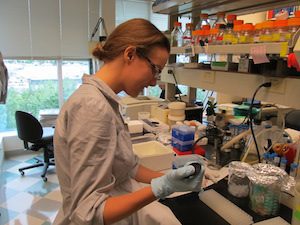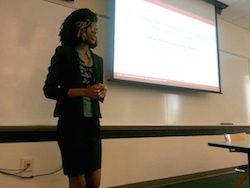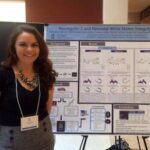Most years, Mary Baldwin University sees one or two students landing spots for undergraduate research internships at other institutions. This year, there were six.
Though the science faculty has increased awareness of such opportunities, it is ultimately up to the students to search for the research sites and host institutions that dovetail with their interests.
“These are very prestigious internships, very competitive, and they pay pretty well,” said Louise Freeman, professor of psychology, adding that the summer experience, called REU (Research Experience for Undergraduates, often funded by government research agencies) helped the six seniors learn more practical applications in their major and helped them be more focused when doing thesis projects.
Three of the students who participated in REUs will present their work to the community over the next few weeks. Senior Sophia Stone — who also participated in an REU at Oklahoma State University in 2013 evaluating endurance exercise and estrogen in — kicked off the series on October 15 with her presentation, “Cofactor interactions in myogenic and neurogenic programming via MyoD and NeuroD2 transcription factors.”

Stone’s most recent REU research at the Fred Hutchinson Cancer Research Center in Seattle involved treating cancer cells with certain compounds that encourage those cells to transform into completely different, non-cancerous cells. Such promising research could go a long way forward understanding how cancer cells behave.
“I think it is important in my own projects to think about the consequences for patients in the future, and to remember that long-term development of treatments for diseases is the result of many, many basic scientific and translational research efforts,” she said. “Hopefully this project has or will lend some sort of contribution to help reach these aims.”
It’s possible that students who have a positive summer experience could influence others to apply.
“What we’re seeing right now is how contagious this can be,” Freeman said. “They’ll talk to their classmates about their experience and maybe we’ll have nine or 10 [REU] students next year.”
Freeman noted that the REU experience demonstrates well the professional application of the liberal arts and sciences. With such experience under their belts, students may be better positioned to land jobs, such as a research technician, or find other professional positions that can lead to a rewarding career.
In addition to the three science students, three math seniors were also selected for REU work over the summer. Natalia de la Torre conducted research at Arizona State University in the mathematical modeling of a needle exchange program in drug treatment therapy. Aria Doughtery’s work at Kansas State University related to quantum theory while Jessica Walker used mathematics to study the dynamics of lasers at the Rochester Institute of Technology (RIT). Both Dougherty and Walker presented their work at the Shenandoah Mathematics and Statistics Conference at James Madison University.

“I absolutely loved the [RIT summer] experience,” Walker said. “It taught me so much more about mathematics and gave me invaluable research experience to utilize in graduate school research. This REU also gave me a jumpstart in thinking about my senior thesis plans by introducing me to bifurcation theory. Even now I’m still learning more and more about bifurcation theory’s physical applications as well as its connections with other fields of math that I’ve studied, and I am actually writing my senior thesis on Hopf bifurcations in dynamical systems.”
Walker will present her work in January in San Antonio at the Mathematical Association of America and American Mathematical Society’s joint conference, dubbed the largest mathematics meeting in the world.
Several students have also found rewarding research opportunities right here on the Mary Baldwin campus. Thanks to the Summer Research Fellows program and the faculty members who introduce important topics to explore, students have translated their work into rich senior theses and posters at national conferences.
For example, four chemistry majors with biochemistry emphases are working on senior projects related to autoimmune diseases like lupus, psoriasis, and rheumatoid arthritis — conditions in which the immune system responds in a harmful way to stray components of cell nuclei. In the last decade, a short protein molecule called LL-37 has been found to carry DNA from extracellular fluids into cells, where it triggers an immune response intended for bacteria and viruses. The interaction of LL-37 with DNA is an important aspect of this process, and research conducted in Pearce Science Center investigates this interaction. Understanding the role of LL-37 in autoimmune diseases can offer insight into future treatments.
After spending the summer 2013 in the lab with Assistant Professor of Chemistry Maria Craig, Irmamarie Avelsgard continues research on this autoimmune disease for her senior project. Other students working on senior projects on LL-37 include Stone, Celine Brooks, and Kaela Kelly, whose REU funded by the National Science Foundation took her to the University of North Carolina this summer.
Another summer research project, funded by the Virginia Foundation for Independent Colleges, earned Inna Kirilyuk an undergraduate research award in Denver at the American Physical Society’s annual meeting. Kirilyuk worked with Assistant Professor of Physics Nadine Gergel-Hackett to build memristors — small, flexible electronic chips that retain memory without power. A better understanding of the physics behind how they work could eventually revolutionize technologies such as artificial intelligence and computing.
Junior Mwazomela Mwebe will also present the results of her summer research in Denver this spring at the American Chemical Society National Meeting and Exposition after working with Assistant Professor of Chemistry Peter Ruiz-Haas to develop methods to destroy Bisphenol-S, or BPS, with UV light. BPS is used in many plastic products as a safer alternative to BPA but may also be just as harmful.

Upcoming student presentations covering topics in chemistry, biology, and psychology:
- On October 23, Alana Rister will present “Printing Drugs on Edible Substrates” at 12:15 p.m. in Francis.
- On October 27, Nhi “T” Nguyen will present “Molecular Interactions Between Peptides and Molecular CLIP” at 7:30 p.m. in room 301 of Pearce Science Center.
- On November 6, Kaela Kelly will present “Neuregulin-1 and Neonatal White Matter Integrity in the Fornix” at 12:15 p.m. in Pearce 301.
Front page image is Alana Rister (far right) with colleagues at the National Institute of Standards and Technology this summer.